Family : Orchidaceae

Text © Prof. Pietro Pavone

English translation by Mario Beltramini
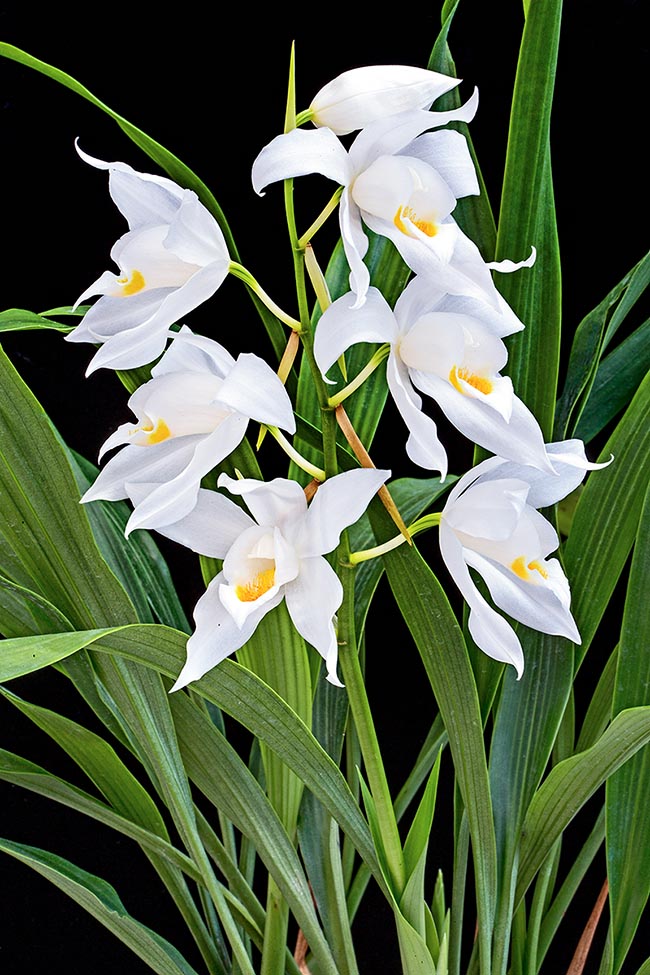
Coelogyne mooreana is native to Vietnam where it grows in the mountain rainforests © Giuseppe Mazza
Coelogyne mooreana Rolfe (1907) is a species of the family Orchidaceae, subfamily Epidendroideae, tribe Arethuseae, subtribe Coelogyninae, native to Vietnam, where it grows in the mountain rainforests at an altitude of 1300-2000 m.
The genus Coelogyne has been described by John Lindley (1799-1865) based on a plant coming from Nepal that he called Coelogyne punctulata Lindl.
It counts about 200 species with a vast geographic distribution. In fact, its species are present in India, southern China, Indonesia, and Fiji Islands.
Its species have prominent pseudobulbs with one or two apical leaves, in some close together in short rhizomes whilst in others far from each other. From the similar orchids of this genus it distinguishes as having the dorsal sepal, over the labellum, concave, trilobate labellum, with erect lateral lobes on the sides of the column, and 4 or 5 fimbriate lamellae (keels) extending for most of the median lobe.
The molecular studies have proved that Coelogyne has a poly- and paraphyletic nature, it is therefore a non natural group. From the molecular data it turns out, also, that there exist convergence phenomena on the floral morphology, as adaptation to the various pollinators, and this renders the traditional taxonomy controversial, however further investigations are necessary for an alternative classification.
Coelogyne mooreana has been found for the first time in the Lang Bian Chain, at 1300 m of altitude. The Lang Bian, or Langbian, sometimes written as Lang Biang, is a mountain 2167 m high that dominates the homonymous plateau, located at 12 km from Đà Lạt, in the province of Lâm Đồng in South Vietnam.
From 2015 the area of Lang Biang, which includes many endangered species present in the international Red Lists, has been declared “Biosphere Reserve” by the UNESCO (United Nations Educational, Scientific and Cultural Organization).
It was Wilhelm Micholitz (1854-1932) who collected it in 1904 for the nurseryman Henry Frederick Conrad Sander (1847-1920), known as the “king of the orchids” of Saint Albans (Hertfordshire, England). This character, with the collaboration of the English landscaper and botanist Henry George Moon (1857-1905), was also the author of the work in four volumes Reichenbachia Orchids Illustrated and Description where are illustrated in full size, almost two hundred orchids and described in English, French and German.
The so called volumes were a tribute to the great orchidologist Heinrich Gustav Reichenbach (1823-1889).
Coelogyne mooreana flowered in 1906 and Robert Allen Rolfe (1855-1921) has validly described it in the magazine Bulletin of miscellaneous information Royal Botanic Gardens, Kew (Bull. Misc. Inform. Kew 129 (1907).
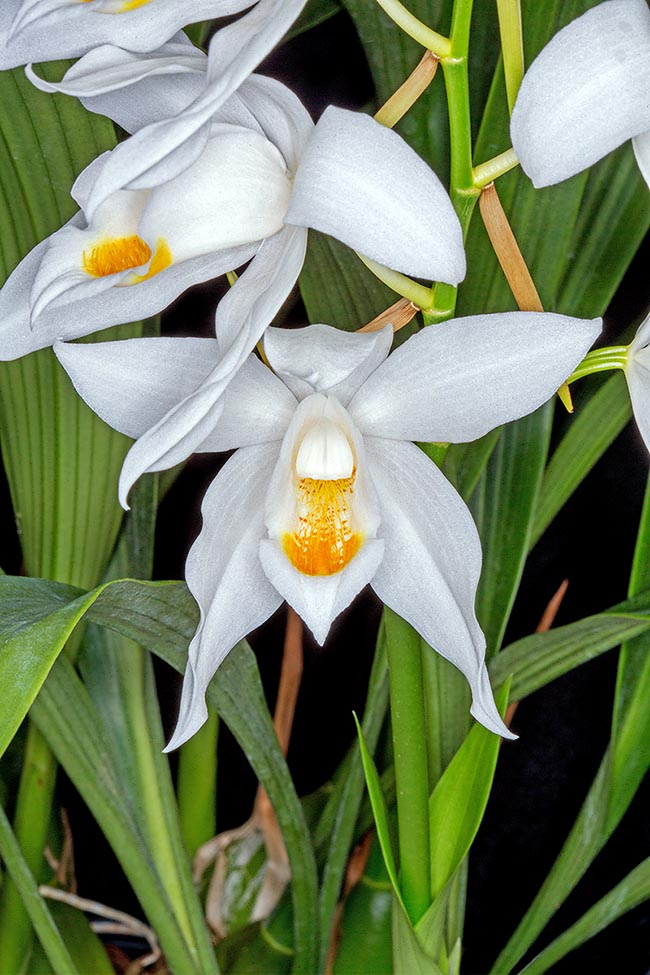
The splendid cultivar Coelogyne mooreana ‘Westonbirt’ was registered in 1908 by the British hybridizer H. G. Alexander who obtained a certificate of cultural commendation by the Royal Horticultural Society © Giuseppe Mazza
Rolfe was the first curator of the herbarium of the orchids of the Royal Botanic Gardens of Kew and founder of the monthly magazine “The Orchid Review” that has produced and edited 28 volumes.
The first monthly number did appear on January 1st, 1893 and the magazine was dedicated to the cultivation and to the hybridization of the orchids. Rolfe and Charles Chamberlain Hurst (1870-1947) published, in 1909, the volume supplementary to the magazine: “The Orchid Stud Book” where they listed all registered hybrids, up to the. end of 1907, together with the parent species, with possible synonyms, references and several photographs.
The name of the genus Coelogyne comes from the Greek words κοίλος (koílos) “empty, hollow” and γῠνή gyné “woman”, with the meaning of feminine for the hollow shape of the upper part of the pistil (stigma).
The specific epithet is honoured to Frederick William Moore (1857-1949) recognized as the leading horticulturist of Ireland and who was president of the Royal Horticultural Society of Ireland and caretaker of the Royal Botanical Gardens of Dublin during the period 1879-1922.
The common name is “Coelogyne of Moore” but in the Anglo-Saxon countries it is called “The Queen of Coelogynes”.
Coelogyne mooreana is a sympodial epiphyte, of moderate size (30-45 cm), with thin and well developed thins, covered by the white velamen. The pseudobulbs are grouped, ovoid, blunt, slightly grooved, and bear two, up to 35 cm long, apical leaves, of glossy green colour, strictly linear-oblanceolate, plicate, with seven vins, more evident in the lower pagina, and with the base tapered to form a long, arcuate, petiole.
The inflorescences appear before the development of the pseudobulbs. As a matter of fact, Coelogyne mooreana is a proteranthous species. The inflorescence is erect, racemose, (15) 30-40 cm long, formed by 4 to 8(12) flowers, that appears in spring and in early summer. The flowers open almost at the same time and are 7-10 cm large, scented, well spaced along the axis of the inflorescence. The spelas and the petals, of white colour, have lanceolate shape with acute apex. The labellum, white too, is trilobate, 3-3,5 cm long, with concave-saccate base, ith oblong lateral lobes, curved and wrapping the column and with ovate median lobe, obtuse often with hairy-papillose disc with 3-4 mm thin hairs of golden yellow or orange color. The column measures about 2-5 cm and is amply winged.
Usually the flowering lasts four to six weeks. The pollinia are two.
Coelogyne mooreana is commercially protected and as such is inserted in the Appendix II of Washington Convention (CITES) that has the purpose to protect the animal and vegetable species under risk of extinction, forbidding their export and detention.
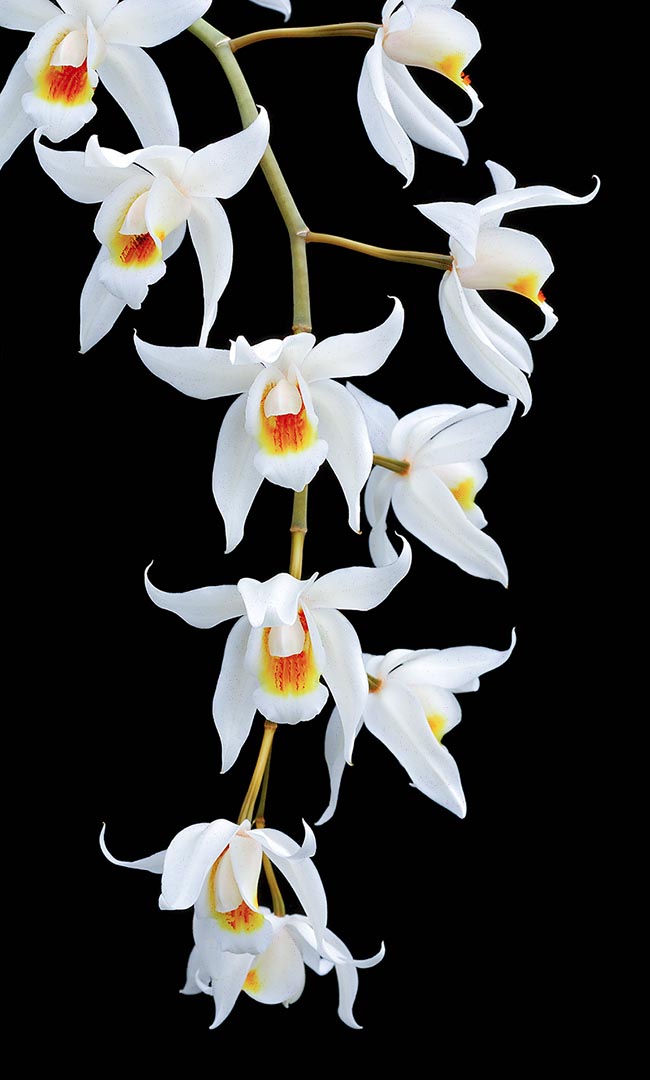
Showy inflorescence of Coelogyne Jannine Banks ‘Snow White’. This multi-award winning hybrid, very particular and rare, has 7-8 cm big flowers, scented, opening in succession during its long blooming © Eric Hunt
Coelogyne mooreana is a very attractive species due to its dramatic flowering and is easy to cultivate even if, only recently, is more easily available on the market.
In amateur cultivation the plant may bloom in times differing from the period of blooming it has in nature. This is good because the summer flowerings are usually compromised by the high temperatures of our climates whilst those between late September and October have usually perfect flowers.
In its origin sites Coelogyne mooreana has a heavy summer cloudy coverage and this indicates that it is necessary to shade the plants from spring to autumn. In its habitat, winter is the brightest season therefore it is necessary to administer more light (25000 lux or more) but attention is to be paid in never burning the leaves. Moreover a strong movement of air must be always guaranteed to the plants.
Despite being in tropical areas, this species grows at high altitudes, where summer is warm and humid and winter is cold and dry.
Furthermore, in the origin sites the average day temperature in summer is of 25-26 °C, the night is of 17 °C, with a daily fluctuation of 6-8 °C. In spring, the average day temperature is of 27-28 °C. In winter, the average daily temperature is of 25-26 °C, the night it drops to 12-13 °C with a daily temperature excursion of 13-14 °C.
Therefore, we can consider it as a plant with moderate thermic demands.
During the season of the summer monsoons, that lasts 4-6 months, rainfall is very abundant whilst the winter monsoon, lastinge even several months, lowers the temperature and does not carry rain. Consequently, in cultivation, the plants need a humidity of almost 85% in summer and in early spring, and 60-70% in early winter.
Coelogyne mooreana can grow stuck to pieces of tree fern or cork slabs, but can also be planted in baskets utilizing a loose substratum able to dry up quickly. As substrata are good small and medium sized barks, fibres of tree ferns or mixtures with addition of charcoal, perlite or moss of sphagnum.
Repotting can be done when the plant grows out of the basket, but the roots must not be damaged. This care is useful for its growth because this species does not accept the repotting and, in this case, requires a long time (2-3 years) for recovery.
Nevertheless, if repotting is necessary, this must be done when the new roots begin to grow in order to guarantee a faster rooting.
During the time of active growth Coelogyne mooreana requires abundant waterings with a drying between one watering and the other. When autumn comes, the quantity of water is to be reduced gradually and in winter only small occasional waterings are sufficient. or morning nebulizations. During the period of strong growth, the plants are to be fertilized every week with 1/4-1/2 the dosage suggested of fertilizer for orchids.
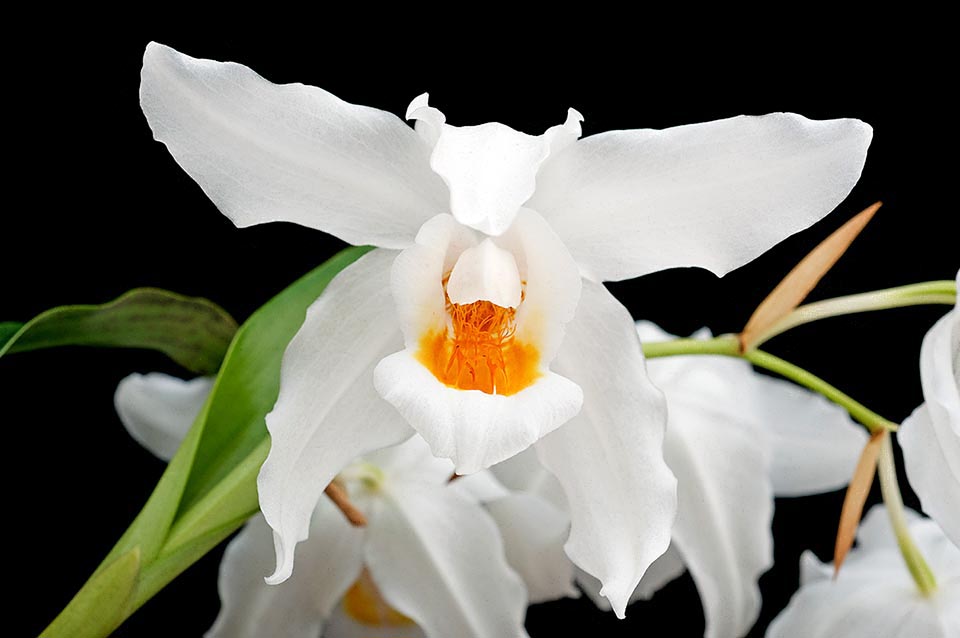
Very sought for by lovers, Coelogyne Linda Buckley ‘Clackamas’ has obtained the high quality certificate (Highly Commended Certificate) by “The American Orchid Society”. It is a splendid hybrid with white and gold yellow flowers. It has inherited the erect inflorescences of Coelogyne mooreana and shows the Coelogyne cristata wavy sepals © Eric Hunt
It is possible to utilize fertilizers with a low contents of nitrogen in late summer and in autumn and an increase of phosphorus in order to improve the flowering in the following season and to strengthen the growth before winter. In order not to accumulate the mineral deposits caused by the fertilizations, it is suggested to rinse the containers periodically. If the apices of the leaves appear dry and the pseudobulbs wrinkled, the quantity of administered water must be increased.
The leaves on the oldest pseudobulbs dry up naturally whilst it is normal that the young pseudobulbs may have small but not excessive wrinkles because this shows a high lack of water. Moreover, if there is an excess of watering the plant might not blossom.
Several hybrids exist in cultivation and, in 1950, Micholitz himself was honoured with a beautiful hybrid registered under his name as Coelogyne Memoria W. Micholitz, Sanders [St Albans] with big flowers of brown and white colour, obtained from the cross between Coelogyne lawrenceana × Coelogyne mooreana.
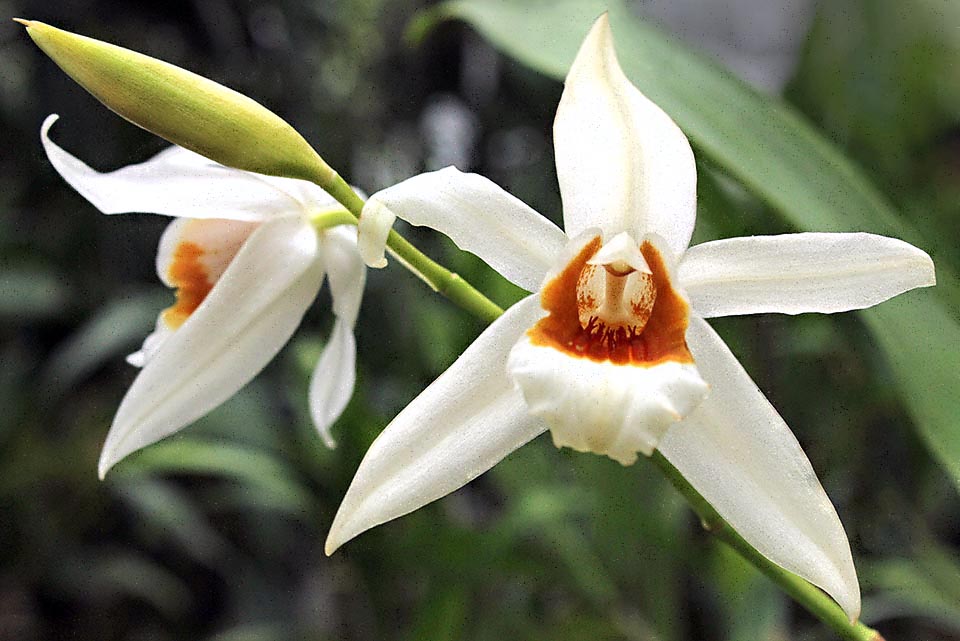
Coelogyne Memoria W. Micholitz, hybrid of Coelogyne lawrenceana x Coelogyne mooreana, recalls the plant hunter Wilhelm Micholitz © Peter Turski
Other hybrids of Coelogyne mooreana registered until 2020 in “The International Orchid Register” are:
Coelogyne Edward Pearce, R Pearce, 1995 (Coelogyne fragrans × Coelogyne mooreana);
Coelogyne G. Beryl Read, Dennis Read, 2008 (Coelogyne salmonicolor × Coelogyne mooreana);
Coelogyne Jannine Banks, David Banks 1995 (Coelogyne mooreana × Coelogyne flaccida);
Coelogyne Joel Strandberg, J.Ritchie 2006 (Coelogyne confusa × Coelogyne mooreana)
Coelogyne John Leathers, R. Hamilton 2008 (Coelogyne corymbosa × Coelogyne mooreana);
Coelogyne Keith Spence, P.Spence 2009 (Coelogyne Andreé Millar × Coelogyne mooreana );
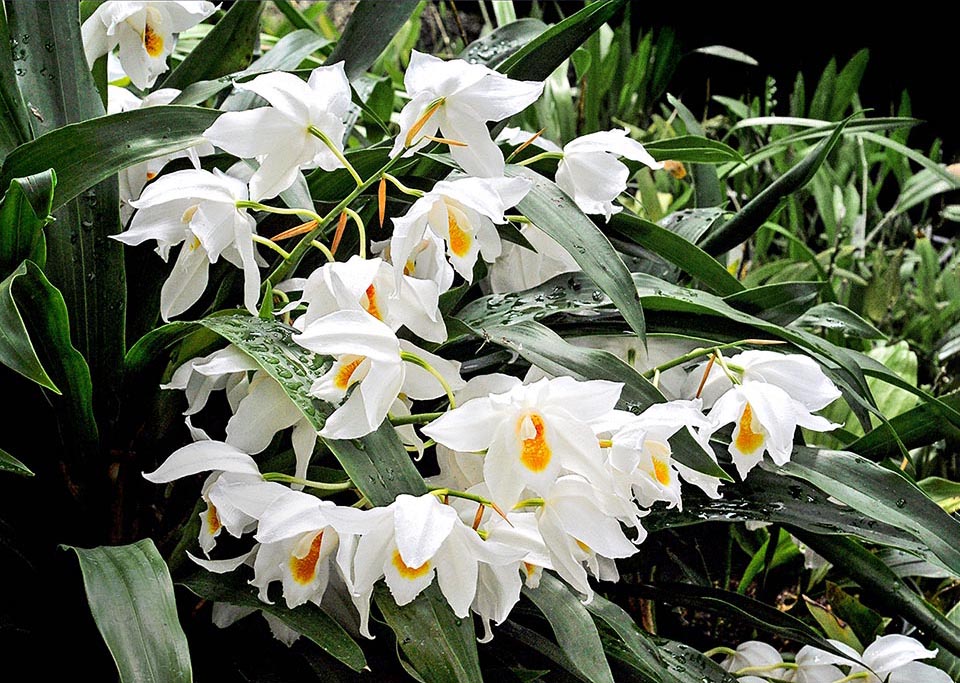
Coelogyne mooreana ‘Brockhurst’ has gotten by “The Royal Horticultural Society” the “First Class Certificate”, prestigious award for the very high quality © Ron Parsons
Coelogyne Linda Buckley, R.Hull 1989 (Coelogyne mooreana × Coelogyne cristata);
Coelogyne Memoria Louis Forget, P.Sander 1994 (Coelogyne speciosa × Coelogyne mooreana);
Coelogyne Kirribilli Sarah Jean, K.Dawes 2015 (Coelogyne mooreana × Coelogyne ovalis);
Coelogyne Kirribilli Marie, K.Dawes 2013 (Coelogyne mooreana × Coelogyne usitana);
Coelogyne Kirribilli Ellen, K.Dawes 2014 (Coelogyne mooreana × Coelogyne assamica);
Coelogyne Andrew Banks, Hills Dist. 2015 (Coelogyne stricta × Coelogyne mooreana);
Coelogyne Lynette Banks, Hills Dist. 2015 (Coelogyne Mem. W. Micholitz × Coelogyne mooreana);
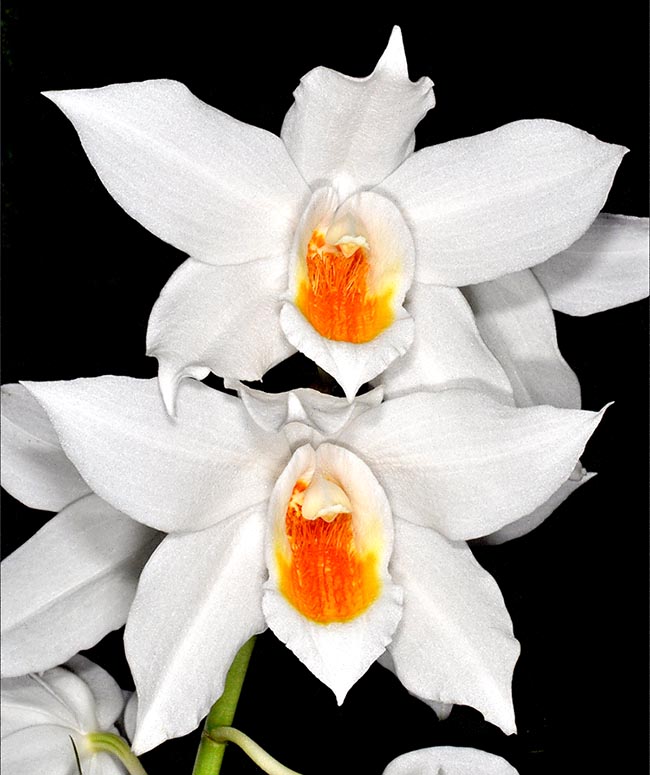
In fact Coelogyne mooreana ‘Brockhurst’ displays compact inflorescences and big gently fragrant 7 cm flowers © Ron Parsons
Coelogyne Rachael Banks, Hills Dist. 2015 (Coelogyne Mem. Louis Forget × Coelogyne mooreana);
Coelogyne Kirribilli Gillian, K.Dawes 2015 (Coelogyne mooreana × Coelogyne huettneriana);
Coelogyne Kirribilli Charlie, K.Dawes 2016 (Coelogyne Amber × Coelogyne mooreana);
Coelogyne Kirribilli Megan, K.Dawes 2016 (Coelogyne mooreana × Coelogyne marmorata);
Coelogyne Kirribilli Stephanie, K.Dawes 2014 (Coelogyne mooreana × Coelogyne brachyptera);
Coelogyne Kirribilli Jimmy, K.Dawes 2019 (Coelogyne calcicola × Coelogyne mooreana);
Coelogyne Kirribilli Janet Dixon-Smith, K.Dawes 2017 (Coelogyne mooreana × Coelogyne celebensis).
Coelogyne mooreana-ochracea 2020 (Coelogyne mooreana × Coelogyne ochracea (syn. Coelogyne nitida)
The following secondary hybrids have been registered:
Coelogyne Kirribilli Colin, K.Dawes 2016, utilizing Coelogyne Memoria W. Micholitz (Coelogyne mooreana × Coelogyne lawrenceana) × Coelogyne usitana ‘Golden Gate’); Coelogyne Kirribilli Jennifer O’Brien, K.Dawes 2017 (Coelogyne mooreana ‘Brockhurst’ × Coelogyne Unchained Melody ‘Alba’).
Also numerous cultivars do exist. The cultivar Coelogyne mooreana ‘Westonbirt’ was registered in 1908 obtaining a certificate of cultural commendation by the Royal Horticultural Society (CCC/RHS). It was the British hybridizer H.G. Alexander (1875-1972) to select it while working for Sir George Lindsay Holford (1860-1926) at the Westonbirt House, Gloucestershire (England).
The last awarded cultivars are: Coelogyne mooreana ‘Wössen’ (4 wards from 2013 to 2016); Coelogyne mooreana ‘Brockhurst’ (3 awards from 1984 to 1998); Coelogyne mooreana ‘Keri’ (2 awards in 2012); Coelogyne mooreana f. alba ‘Günther’ (2018); Coelogyne mooreana ‘Ingrid’ (2017); Coelogyne mooreana f. alba ‘Reinhold’ (2016); Coelogyne mooreana ‘Franz’ (2016); Coelogyne mooreana ‘Deggendorf’ (2014); Coelogyne mooreana f. alba ‘Mirjam’ (2013); Coelogyne mooreana ‘White Star’ (2001); Coelogyne mooreana h.v. Brockhurst ‘Wylde’ (1997); Coelogyne mooreana ‘Crestwood’ (1983).
Synonyms: Coelogyne mooreana f. alba Roeth & O.Gruss (2001); Coelogyne psectrantha Gagnep. (1930).
